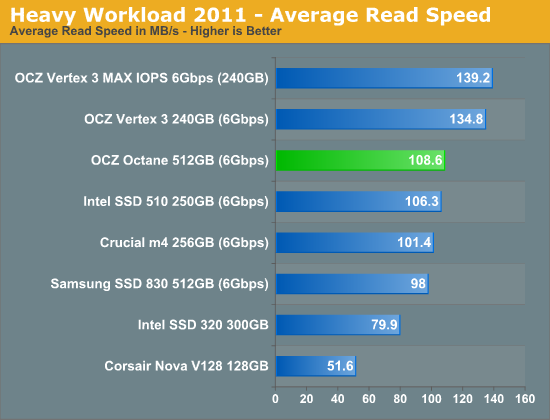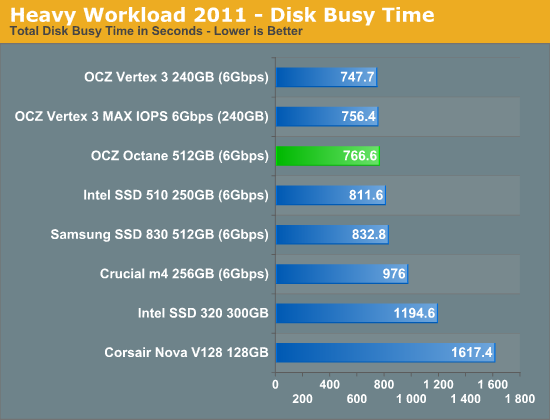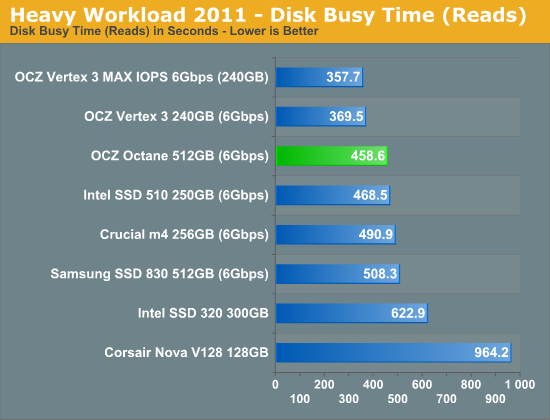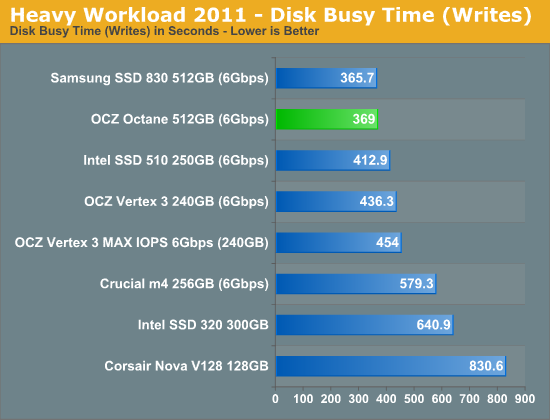The OCZ Octane Review (512GB)
by Anand Lal Shimpi on November 23, 2011 12:00 PM ESTAnandTech Storage Bench 2011
Last year we introduced our AnandTech Storage Bench, a suite of benchmarks that took traces of real OS/application usage and played them back in a repeatable manner. I assembled the traces myself out of frustration with the majority of what we have today in terms of SSD benchmarks.
Although the AnandTech Storage Bench tests did a good job of characterizing SSD performance, they weren't stressful enough. All of the tests performed less than 10GB of reads/writes and typically involved only 4GB of writes specifically. That's not even enough exceed the spare area on most SSDs. Most canned SSD benchmarks don't even come close to writing a single gigabyte of data, but that doesn't mean that simply writing 4GB is acceptable.
Originally I kept the benchmarks short enough that they wouldn't be a burden to run (~30 minutes) but long enough that they were representative of what a power user might do with their system.
Not too long ago I tweeted that I had created what I referred to as the Mother of All SSD Benchmarks (MOASB). Rather than only writing 4GB of data to the drive, this benchmark writes 106.32GB. It's the load you'd put on a drive after nearly two weeks of constant usage. And it takes a *long* time to run.
1) The MOASB, officially called AnandTech Storage Bench 2011 - Heavy Workload, mainly focuses on the times when your I/O activity is the highest. There is a lot of downloading and application installing that happens during the course of this test. My thinking was that it's during application installs, file copies, downloading and multitasking with all of this that you can really notice performance differences between drives.
2) I tried to cover as many bases as possible with the software I incorporated into this test. There's a lot of photo editing in Photoshop, HTML editing in Dreamweaver, web browsing, game playing/level loading (Starcraft II & WoW are both a part of the test) as well as general use stuff (application installing, virus scanning). I included a large amount of email downloading, document creation and editing as well. To top it all off I even use Visual Studio 2008 to build Chromium during the test.
The test has 2,168,893 read operations and 1,783,447 write operations. The IO breakdown is as follows:
| AnandTech Storage Bench 2011 - Heavy Workload IO Breakdown | ||||
| IO Size | % of Total | |||
| 4KB | 28% | |||
| 16KB | 10% | |||
| 32KB | 10% | |||
| 64KB | 4% | |||
Only 42% of all operations are sequential, the rest range from pseudo to fully random (with most falling in the pseudo-random category). Average queue depth is 4.625 IOs, with 59% of operations taking place in an IO queue of 1.
Many of you have asked for a better way to really characterize performance. Simply looking at IOPS doesn't really say much. As a result I'm going to be presenting Storage Bench 2011 data in a slightly different way. We'll have performance represented as Average MB/s, with higher numbers being better. At the same time I'll be reporting how long the SSD was busy while running this test. These disk busy graphs will show you exactly how much time was shaved off by using a faster drive vs. a slower one during the course of this test. Finally, I will also break out performance into reads, writes and combined. The reason I do this is to help balance out the fact that this test is unusually write intensive, which can often hide the benefits of a drive with good read performance.
There's also a new light workload for 2011. This is a far more reasonable, typical every day use case benchmark. Lots of web browsing, photo editing (but with a greater focus on photo consumption), video playback as well as some application installs and gaming. This test isn't nearly as write intensive as the MOASB but it's still multiple times more write intensive than what we were running last year.
As always I don't believe that these two benchmarks alone are enough to characterize the performance of a drive, but hopefully along with the rest of our tests they will help provide a better idea.
The testbed for Storage Bench 2011 has changed as well. We're now using a Sandy Bridge platform with full 6Gbps support for these tests.
AnandTech Storage Bench 2011 - Heavy Workload
We'll start out by looking at average data rate throughout our new heavy workload test:

When put to the test the Octane does not disappoint. It's within a couple MB/s of the SF-2281 based Vertex 3, and effectively one of the fastest 6Gbps drives on the market today. I included the old Indilinx Barefoot based Corsair Nova V128 to show just how far Indilinx has come here.


The next three charts just represent the same data, but in a different manner. Instead of looking at average data rate, we're looking at how long the disk was busy for during this entire test. Note that disk busy time excludes any and all idles, this is just how long the SSD was busy doing something:













75 Comments
View All Comments
Chloiber - Wednesday, November 23, 2011 - link
...now let's wait what Indilinx has learned from the Barefoot fiasco. The performance looks good - so does the performance of the competition. The only things that matter now are 1) reliability, 2) price and 3) performance over time.IceDread - Thursday, November 24, 2011 - link
Reliability is very important, performance and price are as well of course but without reliability the later two does not really matter.So it will be interesting to later know the statistics there.
Zane K - Sunday, November 27, 2011 - link
I work at quite a large computer shop, and we sell a heap of OCZ drives. Unfortunately we see 12-14% of these come back compared to 2-4% for out corsair force 3 and Silicon Power drives, until this works its self out, I will neither buy or recommend a ocz drive.dj christian - Monday, November 28, 2011 - link
I agree completely!This says it all
http://www.hardware.fr/articles/843-7/ssd.html
- Intel 0,1% (contre 0,3%)
- Crucial 0,8% (contre 1,9%)
- Corsair 2,9% (contre 2,7%)
- OCZ 4,2% (contre 3,5%)
dj christian - Monday, November 28, 2011 - link
Sorry forgot the above is the reliability indexTranslated for you
http://translate.googleusercontent.com/translate_c...
happycamperjack - Friday, December 2, 2011 - link
Comparing last gen SSD with this Gen of SSD is hardly fair. But I guess Vertex 3 series had suffered earlier this year from a firmware bug, but it''s solved now. Should be smooth sailing from now. I would probably get Vertex 3 over Octane though.maxgrax - Wednesday, November 23, 2011 - link
Definitely going to wait for reliability results before I jump back onto OCZ. They still have the best performance / $ but that has little meaning when data security is at risk. Was hoping after yesterday's preview that you would have more than just the 512GB drive benched :( , I hope the speed doesnt degrade too much going down to 256 and 128Marlin1975 - Wednesday, November 23, 2011 - link
How about testing with a SB950 AMD 6Gb controllerLike to see what diff the newwest Intel vs AMD controllers are.
That and more 128gb reviews. most don;t have SSDs and even fewwer have 512gb models.
inighthawki - Wednesday, November 23, 2011 - link
I would love to see a lot more tests runs on SSDs with less storage. Many of the drives have higher performance in the higher capacity models, and it's pretty obvious that your even your above average tech savvy user isn't going to be dishing out one thousand dollars for the 512GB version of the drive.You should perhaps try to keep all of the tests in the same size range (IE, test all 120/128GB drives, all 250/256GB drives, etc in a single batch).
Anand Lal Shimpi - Wednesday, November 23, 2011 - link
I agree completely, but all we got this round was the 512GB drive. I'm still waiting for lower capacities :)Take care,
Anand